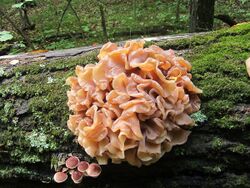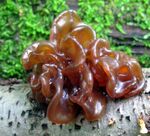Biology:Phaeotremella
| Phaeotremella | |
|---|---|

| |
| Gelatinous fruit body of Phaeotremella frondosa | |
| Scientific classification | |
| Domain: | Eukaryota |
| Kingdom: | Fungi |
| Division: | Basidiomycota |
| Class: | Tremellomycetes |
| Order: | Tremellales |
| Family: | Phaeotremellaceae |
| Genus: | Phaeotremella Rea (1912) |
| Type species | |
| Phaeotremella pseudofoliacea Rea
| |
Phaeotremella is a genus of fungi in the family Phaeotremellaceae. All Phaeotremella species are parasites of other fungi and produce anamorphic yeast states. Basidiocarps (fruit bodies), when produced, are gelatinous and are colloquially classed among the "jelly fungi". Fifteen or so species of Phaeotremella are currently recognized worldwide. Tremella sanguinea, shown to be a Phaeotremella species by DNA sequencing, is cultivated in China as an ingredient in traditional Chinese medicine.[1]
Taxonomy
History
The genus Phaeotremella was originally created by British mycologist Carleton Rea to accommodate Phaeotremella pseudofoliacea, a fungus that resembled a Tremella species but had brown rather than white basidiospores. Later authors considered this to be a mistaken observation and placed Phaeotremella in synonymy with Tremella and its type species in synonymy with Tremella foliacea.[2][3]
Molecular research, based on cladistic analysis of DNA sequences, has however shown that Tremella is paraphyletic (and hence artificial).[4][5][6][7] A different generic name was therefore required for a group of species not closely related to Tremella mesenterica (the type species of Tremella) and Phaeotremella was selected as the earliest such name available.[8] As a result, the current definition of Phaeotremella is not the same as Rea's original concept. The type species, P. pseudofoliacea, has been placed in synonymy with Phaeotremella frondosa.[9]
Description
Fruit bodies (when present) are gelatinous. In some species they are small (under 5 mm across) and pustular to pulvinate (cushion-shaped). In others they are much larger (up to 150 mm across) and may be variously lobed or foliose (with leaf-like or seaweed-like fronds). Several Phaeotremella species are, however, only known from their yeast states.[10]
Microscopic characters
Phaeotremella species produce hyphae that are typically (but not always) clamped and have haustorial cells from which hyphal filaments seek out and penetrate the hyphae of the host.[11] The basidia are "tremelloid" (globose to ellipsoid and vertically or diagonally septate), giving rise to long, sinuous sterigmata or epibasidia on which the basidiospores are produced. These spores are smooth, globose to ellipsoid, and germinate by hyphal tube or by yeast cells. Conidiophores are often present, producing conidiospores that are similar to yeast cells.[4]
Habitat and distribution
Most species are parasitic on members of the corticioid fungi, specifically species of Aleurodiscus and Stereum, with one species on the ascomycetous genus Lophodermium. Those on Aleurodiscus, including Phaeotremella mycophaga, parasitize the fruit bodies of their hosts;[11] those on Stereum, such as Phaeotremella foliacea, P. frondosa, and P. fimbriata, parasitize the host mycelium within the wood.[9]
As a group, Phaeotremella species occur worldwide, though individual species may have a more restricted distribution.[9]
Species and hosts
Only species producing basidiocarps (fruit bodies) are listed. Not all hosts are known.
| Image | Name | Distribution | Host |
|---|---|---|---|
| Phaeotremella dejopia | North America | Stereum gausapatum | |
| Phaeotremella eugeniae | Russian Far East | unknown[9] | |
| Phaeotremella fimbriata | Europe | Stereum rugosum[9] | |
| Phaeotremella foliacea | Europe, North America, northern Asia | Stereum sanguinolentum [9] | |
 |
Phaeotremella frondosa | Europe, North America, northern Asia | Stereum spp[9] |
| Phaeotremella fuscosuccinea | Taiwan, Russian Far East | Stereum sanguinolentum[4][9] | |
| Phaeotremella mycetophiloides | Japan | Aleurodiscus amorphus and A. grantii[12] | |
 |
Phaeotremella mycophaga | Europe, North America | Aleurodiscus amorphus and A. grantii[12] |
| Phaeotremella roseotincta | Japan, Russian Far East | unknown[13] | |
| Phaeotremella simplex | Europe, North America | Aleurodiscus amorphus and A. thujae[14][12] | |
| Phaeotremella translucens | Europe, North America, Japan, New Zealand | Lophodermium species[15] |
References
- ↑ "Purification of polysaccharide produced by the haploid yeast strain of Tremella sanguinea and its antioxidant and prebiotic activities". Molecules 28. 2023. doi:10.3390/molecules28145391. PMID 37513263.
- ↑ Donk MA. (1958). "The generic names proposed for hymenomycetes – VIII". Taxon 7 (8): 236–250. doi:10.2307/1217280.
- ↑ Roberts P. (1999). "British Tremella species II: T. encephala, T. steidleri & T. foliacea". Mycologist 13 (3): 127–131. doi:10.1016/S0269-915X(99)80044-5.
- ↑ 4.0 4.1 4.2 Chen C-J. (1998). Morphological and molecular studies in the genus Tremella. Berlin: J. Cramer. pp. 225. ISBN 978-3-443-59076-5.
- ↑ "Biodiversity and systematics of basidiomycetous yeasts as determined by large-subunit rDNA D1/D2 domain sequence analysis". International Journal of Systematic and Evolutionary Microbiology 50 (3): 1351–1371. 2000. doi:10.1099/00207713-50-3-1351. PMID 10843082. http://ijs.sgmjournals.org/cgi/reprint/50/3/1351.pdf. Retrieved 2010-04-21.
- ↑ "New taxa in the Tremellales: Bulleribasidium oberjochense gen. et sp. nov., Papiliotrema bandonii gen. et sp. nov. and Fibulobasidium murrhardtense sp. nov". Mycologia 94 (5): 873–887. 2002. doi:10.2307/3761703. PMID 21156562.
- ↑ "Phylogeny and phenotypic characterization of pathogenic Cryptococcus species and closely related saprobic taxa in the Tremellales". Eukaryotic Cell 8 (3): 353–361. 2009. doi:10.1128/EC.00373-08. PMID 19151324. PMC 2653247. http://run.unl.pt/bitstream/10362/4019/1/Fonseca_2009.pdf.
- ↑ "Towards an integrated phylogenetic classification of the Tremellomycetes". Studies in Mycology 81: 85–147. 2015. doi:10.1016/j.simyco.2015.12.001. PMID 26955199.
- ↑ 9.0 9.1 9.2 9.3 9.4 9.5 9.6 9.7 "Studies in the Phaeotremella foliacea group (Tremellomycetes, Basidiomycota)". Mycological Progress 17 (4): 451–466. 2018. doi:10.1007/s11557-017-1371-4.
- ↑ "Phaeotremella camelliae sp. nov. (Phaeotremellaceae, Tremellales), A Novel Yeasts Isolated from Tea-Oil Fruits in Jiangxi Province, China". Microbiology 77 (10): 3168–3173. 2020. doi:10.1007/s00284-020-02061-9. PMID 32514781.
- ↑ 11.0 11.1 "Mycoparasitism of some Tremella species". Mycologia 86 (1): 49–56. 1994. doi:10.2307/3760718.
- ↑ 12.0 12.1 12.2 "On some species of Tremella associated with Corticiaceae". Transactions of the Mycological Society of Japan 34: 21–36. 1993.
- ↑ "The genus Tremella (Tremellales, Basidiomycota) in Russia with description of two new species and proposal of one nomenclatural combination". Phytotaxa 238: 40–70. 2015. doi:10.11646/phytotaxa.238.1.2.
- ↑ Roberts P. (2001). "British Tremella species III: Tremella callunicola sp. nov., T. invasa, T. sarniensis sp. nov., T. simplex & T. versicolor". Mycologist 15 (4): 146–150. doi:10.1016/S0269-915X(01)80002-1.
- ↑ "Taxonomic study of polymorphic basidiomycetous fungi Sirobasidium and Sirotrema: Sirobasidium apiculatum sp. nov., Phaeotremella translucens comb. nov. and rediscovery of Sirobasidium japonicum in Japan". Antonie van Leeuwenhoek 115: 1421–1436. 2022. doi:10.1007/s10482-022-01787-9. https://www.researchsquare.com/article/rs-1461453/latest.pdf.
Wikidata ☰ Q27863235 entry
 |

